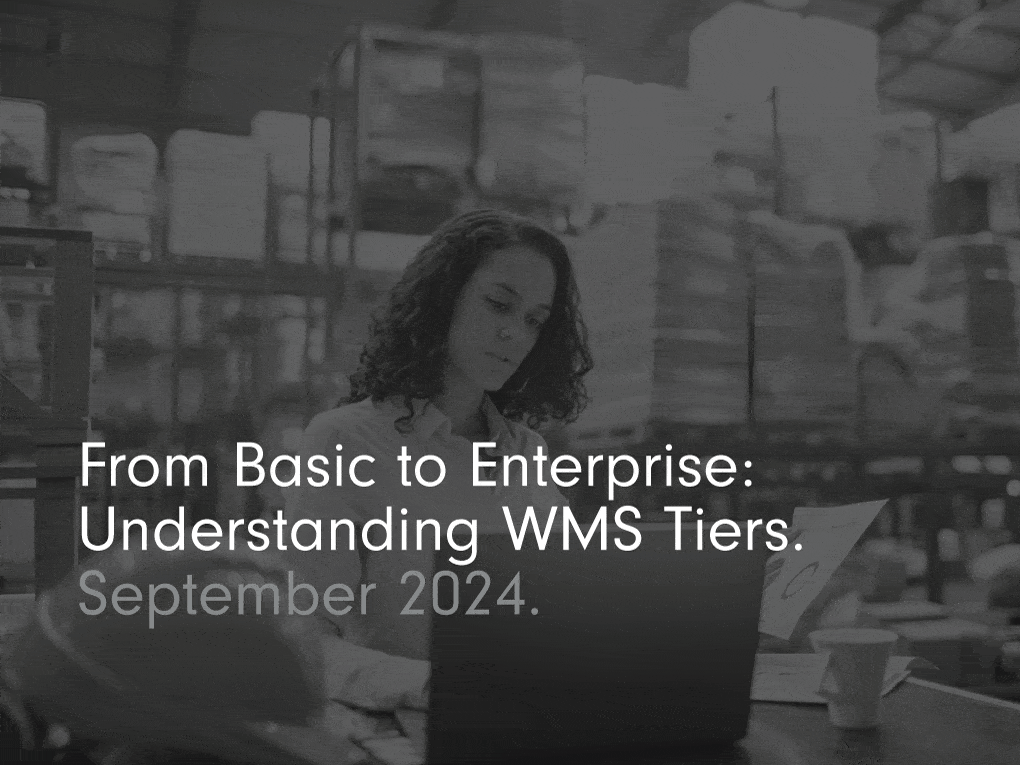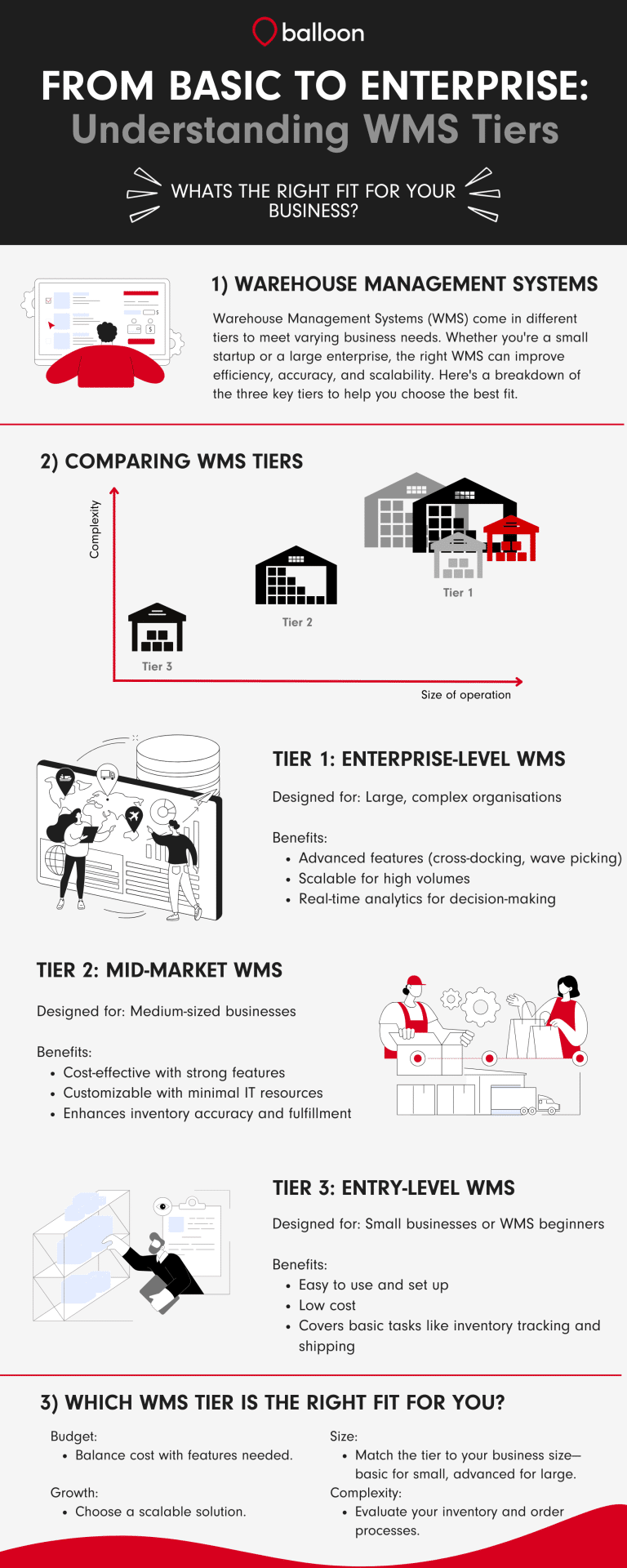From Basic to Enterprise: Understanding WMS Tiers

Efficient warehouse management is crucial. Warehouse Management Systems (WMS) play a key role in optimising supply chain operations. Not all WMS solutions are the same.
They come in different levels, each tailored to meet various organisational needs. Knowing these levels can help you choose the best system for your business.
Whether you’re a supply chain manager, warehouse worker, or tech fan, this guide will explain how WMS has changed, the different types, and how to choose the best one for your business.
The Evolution of WMS.
Warehouse Management Systems have evolved from simple stock tracking to advanced tools. They use automation, manage labour, and provide real-time data. These systems reduce human error, improve picking, packing, and shipping, and help enhance customer service.
Today, WMS solutions are essential in supply chains. They offer features like task mixing, mobile robots, and retrieval systems. These tools help businesses meet customer demands and reduce costs efficiently.
Comparing WMS Tiers: Benefits, Features, and Suitability.

Tier 1: Enterprise-Level WMS
Enterprise-level WMS solutions cater to large organisations with complex warehouse environments. These systems offer comprehensive features, making them suitable for distribution centres and large-scale warehouse operations. Key benefits include:
- Comprehensive Functionality: Supports complex processes such as cross-docking, wave picking, and task interleaving.
- Scalability: Handles high transaction volumes and supports multi-warehouse environments, seamlessly integrating with enterprise resource planning (ERP) systems and other solutions.
- Advanced Analytics: Provides real-time insights to optimise labour management and inventory management.
Tier 2: Mid-Market WMS
Mid-market WMS solutions are great for medium-sized businesses with some complex needs. They balance features and costs, boosting warehouse efficiency without needing lots of IT help. Key benefits include:
- Cost-Effectiveness: More affordable than Tier 1 solutions, while still offering essential functionality for automating warehouse processes.
- Flexibility: Can be customised to meet specific business needs.
- Efficiency: Streamlines inventory tracking, order fulfilment, and basic WMS functions, improving overall warehouse productivity.
Tier 3: Entry-Level WMS
Entry-level or basic WMS solutions are designed for small businesses or those just starting with warehouse management systems. They focus on improving fundamental warehouse tasks. Key benefits include:
- Ease of Use: A simple interface allows small teams to adopt with minimal IT infrastructure.
- Affordability: Lower upfront costs and reduced maintenance make it accessible to smaller operations.
- Basic Functionality: Supports essential processes like inventory tracking, picking, and shipping.
How to Choose the Right WMS Tier for Your Business.

Selecting the right WMS tier depends on several factors, such as warehouse size, operational complexity, and budget. Supply chain managers should consider:
- Warehouse Size and Complexity: Larger warehouses or distribution centres may require enterprise-level systems, while smaller ones can benefit from basic WMS solutions.
- Integration Requirements: Determine if the WMS needs to integrate with existing systems, including ERP, customer relationship management (CRM), or e-commerce platforms.
- Budget: Consider the total cost of ownership, including setup, maintenance, and future upgrades, to ensure the system meets long-term needs.
Körber WMS: Edge and Advantage Solutions.

Körber WMS offers two flexible solutions tailored to different business needs:
- Körber WMS Edge: Designed for small to mid-sized businesses, Körber WMS Edge provides essential features like dynamic put-away, barcode-supported picking, and real-time inventory visibility. This scalable system allows businesses to start with basic functionalities and expand as their operations grow.
- Körber WMS Advantage: Built for medium to large enterprises, Körber WMS Advantage offers advanced capabilities such as labour optimisation, automation integration, and multi-warehouse management. This solution is ideal for businesses with high transaction volumes and complex operations.
Implementing WMS: Best Practices and Challenges.

Implementing a WMS can be challenging, but following best practices can ensure a smooth transition:
- Thorough Planning: Conduct a comprehensive needs assessment and develop a detailed implementation plan.
- Stakeholder Involvement: Engage key stakeholders throughout the process to gain buy-in and ensure the system meets their needs.
- Training and Support: Provide thorough training for users and maintain ongoing support to address any issues.
Common challenges include resistance to change, data migration issues, and integration complexities. Addressing these challenges proactively can help avoid disruptions and maximise the benefits of the WMS.
Selecting the Perfect WMS Tier: A Key Decision.
Choosing the right WMS tier is crucial for optimising warehouse management and improving supply chain efficiency. By understanding the different tiers and how they fit your business needs, you can make an informed choice that aligns with your goals and budget.
The right WMS can transform your warehouse operations, enhance productivity, and set your business up for long-term success. If you’re ready to explore WMS options, contact our experts for a consultation to start your journey toward streamlined warehouse management.

Frequently Asked Questions.
A Warehouse Management System (WMS) aims to streamline and optimise warehouse operations. It improves inventory accuracy, enhances order fulfilment, efficiently manages stock levels, and provides real-time data insights for better decision-making. By automating tasks, a WMS reduces operational costs and boosts productivity.
To choose the right WMS tier for your business, think about the size and complexity of your warehouse operations, the need to integrate with other systems (like ERP or CRM), and your budget. Small businesses with basic needs might do well with entry-level solutions, while larger companies with complex operations may need enterprise-level systems with advanced features and scalability.